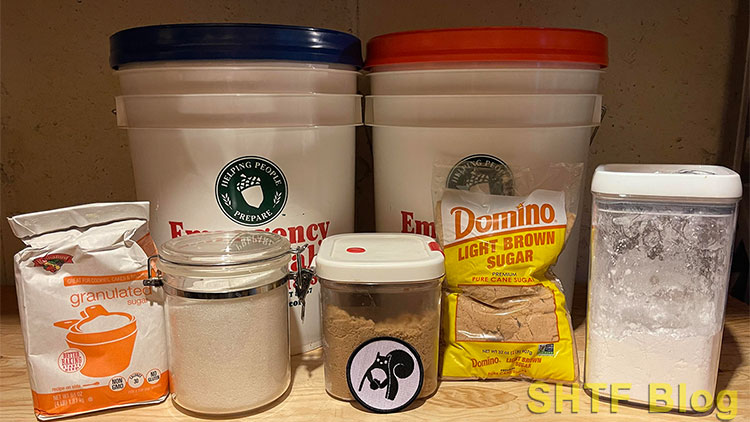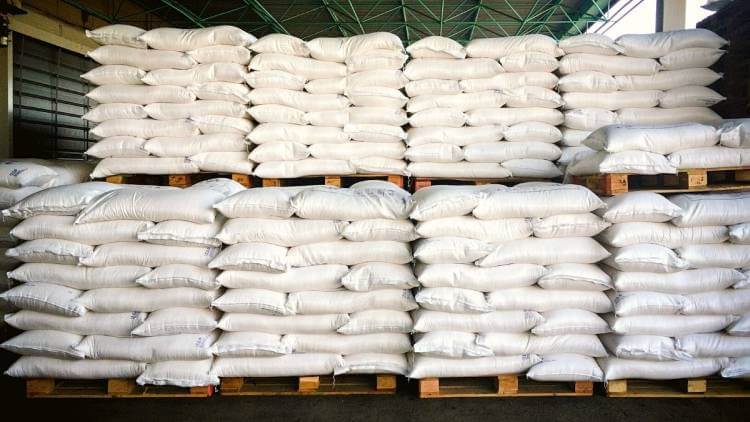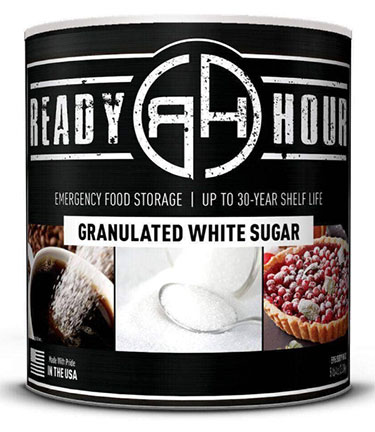
Securing enough food and water to make it through a long-haul disaster is a primary concern as a prepper. Storing rice long-term is a great way to get calories for survival, but it will quickly become bland and boring the longer you eat it. Appetite fatigue is real. Storing sugar long-term is a great way to make your food storage options a bit sweeter for the palette.
No matter what situation we find ourselves in, it is important for us not to just survive but thrive. How do we do this in terms of our diet? How can we keep food exciting to eat?
We take a page out of our ancestor’s playbook and leverage sugar for all its worth.
Sugar also supplies incredible energy density. A mere one ounce of sugar yields 110 calories. When we are trying to shrink our waist size and get in shape, this works against us. However, for prepping, it can be seen as the energy-dense, easily stored, and flavor adding food that it is—all attributes that make a great prepper food.
Finally, sugar is a key component in preserving fruit. It’s used to make jams, jellies, or to can preserves. When we consider a long-haul disaster, several seasons may pass before regular access to food is restored. Having robust sugar stores allows an individual to store fruit season after season.
How Sugar Was Stored Historically
Storing sugar is by no means new. The earliest records of sugar being stored and used in cooking stretch back to 10,000 BC. At first, it was only honey that was being stored and transported around the world. Soon though, sugar cane became known, and with it refined sugar. Our ancient ancestors were well-versed in the value of storing sugar in their root cellars and homes.
Sugar began its journey in southeast Asia and then made its way to India and Arabia. From there it became a staple in Europe and went on to the Americas during the colonial period.

(University of Souther California Libraries and California Historical Society.)
Yet for a substance that cannot be exposed to moisture and is under constant threat from bugs, how did they manage to ship and store it for lengthy periods of time?
In sugar’s early years, its use was limited to the areas surrounding sugar plantations. This was due to raw sugar’s propensity to spoil after it had been processed. Then some monks learned that it could be crystallized and stored in bags. It was at this point that sugar as we know it entered the world.
Bags of sugar were able to be placed on pack animals and taken overland or stored in watertight barrels to be taken across the sea. By the mid-1800s, sugar was being formed in loaves and tightly wrapped in wax paper.
How Long Can You Store Sugar?
Sugar has an indefinite shelf life and does not support any microbial growth. The only way it becomes unusable is if it’s exposed to water.
Though it will keep, it will lose its sweetness over time. For optimal flavor and use it should be consumed within three years. Therefore, it is important to have enough stored properly for the long haul.
It is easy to see how sugar has been a valuable commodity for centuries. In a societal breakdown, sugar is one of the many commodities that will be in short supply. Having enough on hand to be able to trade along with satisfying your own needs will be very important.
What is the Best Type of Sugar to Store?
Not all sugar is the same. There are many different forms of sugar from a few different sources thanks to centuries of refinement and experimentation.
Different forms of sugar will store slightly differently.
- Plain white sugar will keep for virtually forever if stored properly.
- Brown sugar should be consumed within six months if you want to use it at its best. Transfer it to an airtight container after opening it. Brown sugar can harden when it eventually dries out. If you need to soften hard brown sugar, put a slice of bread in the container for a day.
- Powdered sugar can be stored in airtight containers as well, but it is less versatile than granulated sugar.
- Agave is advertised as being good for up to two years. This may be its manufacturer “best by” date, but stored properly, it will last much longer.
- Honey will keep indefinitely but will turn black and the flavor will alter if left unattended. Rotate stock. Honey will crystalize in time, but you can melt it slowly over very low temperatures.
- Maple syrup is good for about a year. Pure maple syrup should be stored in a refrigerator after opening. Imitation maple syrup can be stored in a cool, dry place. It will “spoil” when it begins to grow mold.
When surveying the many options, it would be very easy to get lost in the minutia of each type. What is the best type of sugar to store long-term? No need to overanalyze.
Most Preppers Will Want to Store White Granulated Sugar
Many preppers will argue that honey is the best way to store sugar. This is a solid argument. Honey does last longer, it’s less processed, and has better overall health benefits. It’s a better sugar. However, it’s also much more expensive and impractical for many people to store in quantity.
- Extra fine granulated, free-flowing and of the highest quality
- Premium pure cane sugar
- This all-purpose sugar is ideal for table use, baking, preserving, canning, and for sweetening beverages
- Does Not Contain Any of the 8 Major Allergens
There are four reasons why granulated sugar is best for long-term storage.
- It is simple. For long-term sugar storage and use during hard times, it is best to err on the side of simplicity. White granulated sugar is available everywhere.
- It has a long shelf life. Granulated sugar will outlast everything but honey. You can store a lot of it for a long period of time.
- It has versatility. Honey may have an even longer shelf life, but granulated sugar is more versatile. You can use it for everything from sweetening drinks to making cakes.
- It is affordable. Granulated sugar is extraordinarily cheap to get in large amounts. Visit stores like Sam’s Club and Costco to get larger quantities.
How do Preppers Store Sugar?
How you store sugar will make a big difference in how well it keeps over time. Since sugar has an indefinite shelf life, it does not demand elaborate storage schemes.
Buy it Sealed
If convenience is most important to you, you can buy white granulated sugar already packed for a 30-year shelf life. My Patriot Supply stocked #10 cans of white sugar, and they swear it will taste just as fresh 30 years from now as it does today.
- Five-star reviews
- Stays good for 30 years
- Ready sealed
- Instant energy boost
- 8,925 calories in one can
- Cook, bake, and use for coffee
Made in the U.S.A, you can buy it here.
Canning Jars
A common staple in any pantry is the classic canning jar. Airtight and easily stored, a canning jar is a good option for storing sugar for extended periods of time. They can be purchased at local hardware stores, big-box stores or right online.
- Made in America by the Ball Mason Jar Company
- Single-piece tunable diaphragm is easy to attach, and easier to clean because its surface is smooth without crevices
- Pediatric side converts to a traditional open bell by replacing the single-piece diaphragm with a non-chill rim
- Next-generation tubing provides longer life due to improved resistance to skin oils and alcohol; less likely to pick up stains
Canning jars are not without their limitations Given that they are small it can be expensive to get enough to store a year’s supply for a family. They let light penetrate. They are also prone to breaking.
Mylar Bags
Mylar bags are a common way to store larger amounts of food. They are probably the least expensive way to store large amounts of food. A six-gallon mylar bag will cost about $2 whereas a 32-ounce canning jar will cost .89 cents. This translates to .04 per ounce stored in mylar as opposed to the .36 per ounce stored in canning jars.
- Food-Grade Materials: Our mylar bags are made using food-grade materials that are safe, Durable, and Tasteless.
- Thicker Thickness: The thickness of the mylar bag is 12 mil, and one side is as thick as 6 mil. It has an added internal layer of aluminum foil which provides excellent durability, and puncture resistance, and prevents light and air permeation to keep your food safe and ensure that you can store your food for a longer period.
- Premium Oxygen Absorbers: Each pack of 1 absorbers comes pre-packaged in a factory vacuum-sealed pouch to reduce product exposure and waste.
- Resealable Zipper Bag:The zipper design can be used repeatedly, which is convenient for foods that are often eaten. Sealable with a hot iron or heat-sealing machine for long-term food storage.
- Multi-Purpose: Dehydrates food for storage, including grains, beans, oats, dried fruit, candies, coffee beans, and tea.
The substantial cost savings alone make the case for Mylar, not to mention the simplicity and ease a sealable bag offers over a glass jar with a metal lid.
Note: Do not use oxygen absorbers when storing sugar long-term. Oxygen absorbers will turn the sugar into a brick.
Plastic Buckets
Another feasible option, given sugar’s incorruptible properties, is to store it in food-grade, sealable plastic buckets. These buckets offer the highest level of protection for your sugar stores, but they come at a higher cost.
- Food Grade | BPA Free | HDPE Plastic
- 5 Gallon Capacity, 11.75" Diameter x 14.5" Height (without lid)
- Package contains bucket and easy peel lid, easy peel lid does not require any tools to remove
- Polished surface provides attractive appearance
- Reinforcing ribs maintain container shape, tapered design allows for container nesting
You can sometimes find used food-grade barrels that might otherwise go to waste. I once obtained 6 five-gallon pickle buckets from a sandwich shop that I used for food storage. Problem was, I could never get rid of the pickle smell.
Mixing Mylar bags with buckets is an option if you don’t want to spend the money for them. Line a non-food-grade bucket with a Mylar bag. The Mylar will keep the sugar from coming into contact with the plastic in the bucket.
The Ideal Sugar Storage Place
Sugar is the ideal substance to store. It only has two threats: moisture and ants. It requires only to be kept dry and away from any odors that may impregnate it. Therefore, it is best to store sugar in a cool dry place like a pantry or a root cellar. However, an unused closet or storage building can also work to store sugar.
Store sugar high. The higher it can be kept in storage, the more likely it is to avoid water, absorb odors, or be accosted by ants. Storing sugar in smaller bags to limit weight will allow for it to be stored on the top shelf away from anything that could potentially corrupt it.
How Much Sugar Should You Store?
The average person today consumes 152 pounds of sugar per year. Much of this comes in the form of soft drinks and other processed foods. However, modern man is also plagued with the obesity epidemic as he consumes entirely too much sugar. The American Heart Association recommends that a man only consume nine teaspoons of refined sugar per day (six for women).

When we do the math this equates to just over four gallons of sugar per year. To be safe and for ease of calculation, we can round up to five gallons. That means a year’s supply of sugar should be roughly one five-gallon mylar bag per person per year.
Recommended annual allowance may or may not be a good metric, however. You need to consider what your larger food storage plan looks like. Will you be baking, using recipes that call for large amounts of flour, butter, and sugar? You’re not going to put sugar on most freeze-dried foods. You also won’t use much if your survival food plan is heavy on meat.
Ideally your long-term food storage plan involves some variety. You have plenty of rice stored, beans, freeze-dried foods, basic pantry staples, flour (how to store flour), and – of course – plenty of stored coffee.
Figuring out how much sugar to store for the long-term may involve some guesswork and estimates. If you’re not much of a baker now, consider trying it. Learn a few recipes and ponder how much of the ingredients for those favorites you might need. Trust me, post collapse a pile of fresh-baked cookies will bring a smile to anyone’s face.
Sweet Summary
Sugar is a prepper’s sweet friend. This is not new knowledge, but ancient in origin. From honey to sugar cane to the modern sugar beet, our grandparents knew sugar’s value. It is energy-dense, easy to store, and inexpensive.
With only a small amount of space taken up, enough sugar can be stored to service a family for several years. It should be a staple in every pantry, emergency food storage, and cellar.





